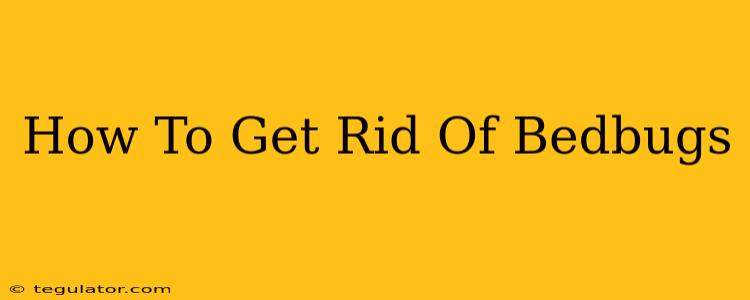Bed bugs. Just the word sends shivers down your spine. These tiny, nocturnal insects are notorious for their itchy bites and persistent infestations. But don't despair! Getting rid of bed bugs is entirely possible with a multi-pronged approach. This comprehensive guide will walk you through the process, from identification to prevention, empowering you to reclaim your sleep and your peace of mind.
Identifying a Bed Bug Infestation
Before you begin the extermination process, it's crucial to confirm you're dealing with bed bugs. Mistaking other insects for bed bugs can lead to ineffective treatments. Look for these telltale signs:
- Bites: Bed bug bites often appear in a line or cluster, causing itchy red welts. However, not everyone reacts to bites, so bites alone aren't conclusive.
- Bed Bugs Themselves: These are small, reddish-brown insects about the size of an apple seed. Check your mattress seams, box springs, bed frame, and surrounding areas. Use a flashlight to aid your search.
- Fecal Spots: Tiny, dark brown or black spots (bed bug feces) on bedding or furniture are a strong indicator.
- Eggs: These are small, pearly white and difficult to spot.
- Shedding Skins: As bed bugs grow, they shed their skins. Finding these shed skins is another sign of infestation.
Don't delay! The sooner you address an infestation, the easier it will be to control.
Effective Bed Bug Treatment Strategies
Getting rid of bed bugs requires a combination of methods. A single approach rarely eradicates the entire infestation. Here's a breakdown of effective strategies:
1. Thorough Cleaning: The Foundation of Bed Bug Control
- Vacuum Everything: This is your first line of defense. Vacuum your mattress, box spring, bed frame, carpets, and surrounding areas meticulously. Pay close attention to seams and crevices. Dispose of the vacuum bag immediately afterward in an outdoor trash can.
- Laundering: Wash all bedding, clothing, and other washable items in hot water (at least 120°F) and dry them on high heat for at least 30 minutes.
- Steam Cleaning: A steam cleaner can effectively kill bed bugs and their eggs on surfaces that can withstand high heat. Target mattresses, furniture, and carpets.
2. Professional Pest Control: When DIY Isn't Enough
For severe infestations or when DIY methods prove ineffective, professional pest control is crucial. Pest control professionals have access to powerful insecticides and specialized techniques that are more effective at eradicating bed bugs. They can also identify hiding places you might miss.
3. Insecticides: Using Them Safely and Effectively
While you can purchase insecticides over-the-counter, it's crucial to use them correctly and safely. Always follow the manufacturer's instructions precisely. Consider the following:
- Types of Insecticides: Several insecticides are effective against bed bugs. Consult with a pest control professional for recommendations.
- Safety Precautions: Use insecticides in well-ventilated areas and wear protective gear, such as gloves and a mask. Keep children and pets away from treated areas.
4. Prevention: Keeping Bed Bugs Away
Preventing bed bugs is just as important as eliminating them. Here's how:
- Regular Inspections: Regularly inspect your bed and surrounding areas for signs of bed bugs.
- Protective Mattress Encasements: These encasements prevent bed bugs from accessing your mattress.
- Careful Baggage Handling: When traveling, inspect hotel rooms carefully and store luggage away from the bed. Wash all clothes upon returning home.
- Decluttering: Reduce clutter to minimize hiding places for bed bugs.
Conclusion: Reclaiming Your Sleep
Getting rid of bed bugs can be challenging, but it's achievable with persistence and the right approach. Combining thorough cleaning, professional pest control where necessary, and preventative measures will significantly increase your chances of success. Remember, early detection and prompt action are key to winning the battle against these persistent pests and regaining a peaceful night's sleep.

